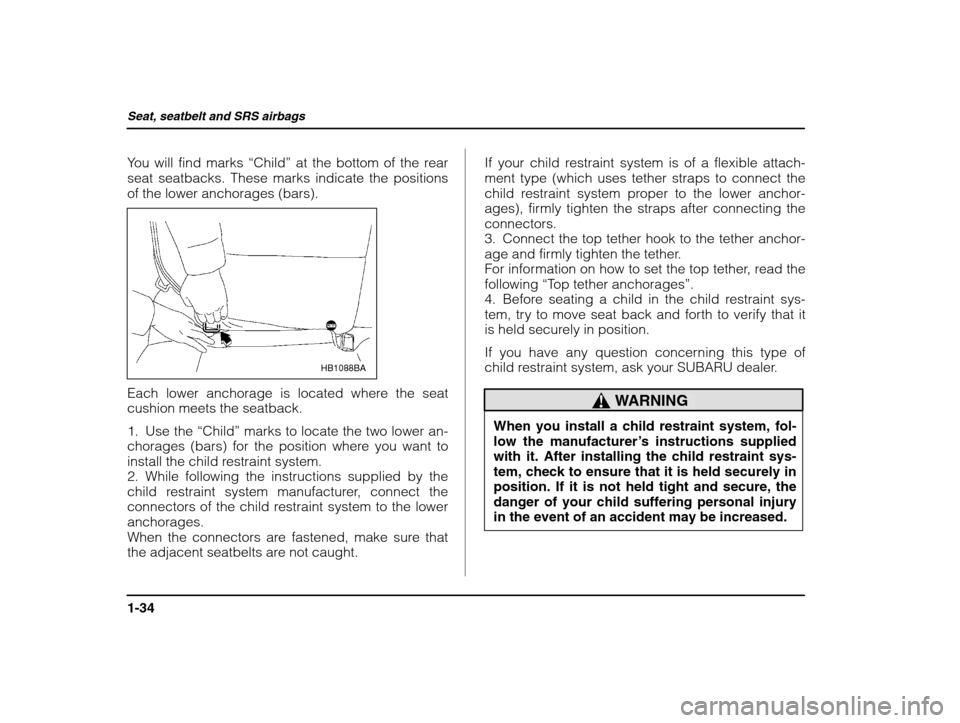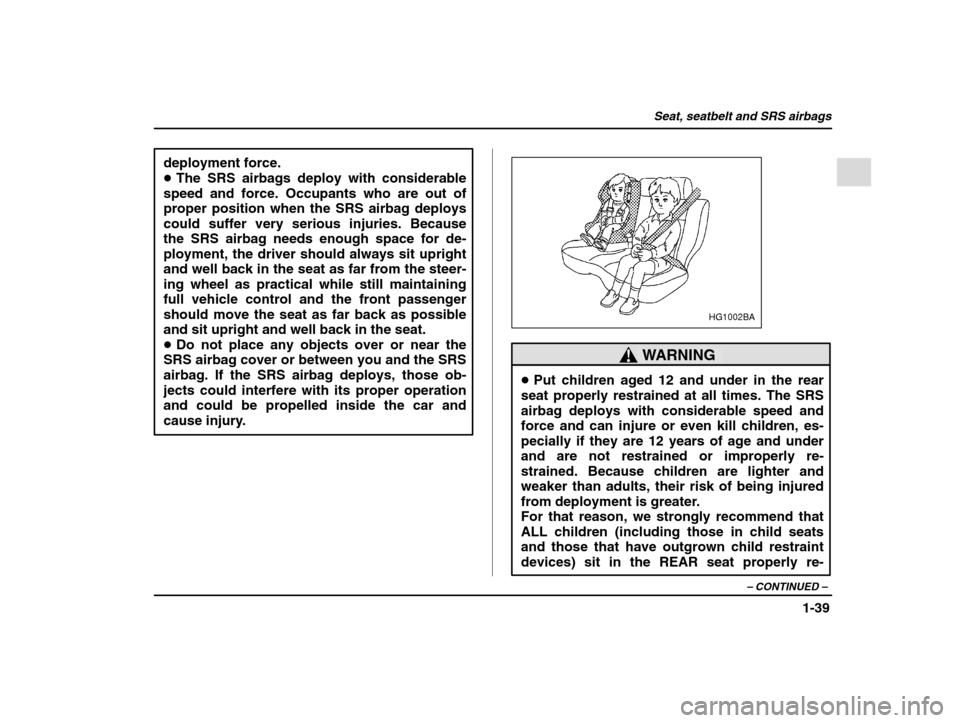Page 53 of 390
Seat, seatbelt and SRS airbags
1-30
HS1031BA
WARNING
SINCE YOUR VEHICLE IS EQUIPPED WITH A
PASSENGER’S SRS AIRBAG, NEVER
INSTALL A REARWARD FACING CHILD SAFE-
TY SEAT IN THE FRONT PASSENGER ’S SEAT.
DOING SO RISKS SERIOUS INJURY OR
DEATH TO THE CHILD BY PLACING THE
CHILD’ S HEAD TOO CLOSE TO THE SRS AIR-
BAG.
HS0042
WARNING
� Child restraint systems and seatbelts can
become hot in a vehicle that has been closed up in sunny weather; they could burn a small child. Check the child restraint system beforeyou place a child in it.� Do not leave an unsecured child restraint
system in your vehicle. Unsecured child re-straint systems can be thrown around inside of the vehicle in a sudden stop, turn or acci-
dent; it can strike and injure vehicle occu-pants as well as result in serious injuries ordeath to the child.
Page 57 of 390

Seat, seatbelt and SRS airbags
1-34
You will find marks “Child” at the bottom of the rear
seat seatbacks. These marks indicate the positions of the lower anchorages (bars).
HB1088BA
Each lower anchorage is located where the seat
cushion meets the seatback.
1. Use the “Child” marks to locate the two lower an-
chorages (bars) for the position where you want to
install the child restraint system.
2. While following the instructions supplied by the
child restraint system manufacturer, connect the
connectors of the child restraint system to the loweranchorages.
When the connectors are fastened, make sure that
the adjacent seatbelts are not caught. If your child restraint system is of a flexible attach-
ment type (which uses tether straps to connect the
child restraint system proper to the lower anchor-
ages), firmly tighten the straps after connecting theconnectors.
3. Connect the top tether hook to the tether anchor-
age and firmly tighten the tether.
For information on how to set the top tether, read the
following “
Top tether anchorages ”.
4. Before seating a child in the child restraint sys-
tem, try to move seat back and forth to verify that it
is held securely in position.
If you have any question concerning this type of
child restraint system, ask your SUBARU dealer.
WARNING
When you install a child restraint system, fol- low the manufacturer ’s instructions supplied
with it. After installing the child restraint sys-tem, check to ensure that it is held securely in
position. If it is not held tight and secure, the
danger of your child suffering personal injuryin the event of an accident may be increased.
Page 61 of 390

Seat, seatbelt and SRS airbags
1-38
*SRS airbag (Supplemental Restraint System airbag)
*SRS: This stands for supplemental restraint system. This name is used because the airbag system sup- plements the vehicle’s seatbelts.
� Vehicle with driver ’s and front pas-
senger’ s SRS airbags and lap/shoul-
der restraints
The supplemental restraint system (SRS) consists oftwo airbags (driver ’s and front passenger ’s frontal
airbags) or four airbags (driver ’s and front passen-
ger’ s frontal airbags and driver ’s and front passen-
ger’ s side airbags).
These SRS airbags are designed only as a sup-plement to the primary protection provided bythe seatbelt.
WARNING
� To obtain maximum protection in the event
of an accident, the driver and all passengers in the vehicle should always wear seatbeltswhen the vehicle is moving. The SRS airbag is
designed only as a supplement to the primary protection provided by the seatbelt. It does
not do away with the need to fasten seatbelts.
In combination with the seatbelts, it offers thebest combined protection in case of a seriousaccident.Not wearing a seatbelt increases the chance of severe injury or death in a crash even when the car has the SRS airbag. For instructions and precautions concerningthe seatbelt system, see the
“Seatbelts” sec-
tions in this chapter.� Do not sit or lean unnecessarily close to the
SRS airbag. Because the SRS airbag deployswith considerable speed – faster than the
blink of an eye – and force to protect in high
speed collisions, the force of an airbag can in-jure an occupant whose body is too close toSRS airbag. It is also important to wear your seatbelt to
help avoid injuries that can result when theSRS airbag contacts an occupant not in prop-er position such as one thrown forward during
pre-accident braking.Even when properly positioned, there remains
a possibility that an occupant may suffer mi- nor injury such as abrasions and bruises to
the face or arms because of the SRS airbag
Page 62 of 390

Seat, seatbelt and SRS airbags
1-39
– CONTINUED –
deployment force. �The SRS airbags deploy with considerable
speed and force. Occupants who are out ofproper position when the SRS airbag deploys
could suffer very serious injuries. Becausethe SRS airbag needs enough space for de- ployment, the driver should always sit upright and well back in the seat as far from the steer-ing wheel as practical while still maintainingfull vehicle control and the front passengershould move the seat as far back as possibleand sit upright and well back in the seat. � Do not place any objects over or near the
SRS airbag cover or between you and the SRS airbag. If the SRS airbag deploys, those ob-jects could interfere with its proper operationand could be propelled inside the car and
cause injury.
HG1002BA
WARNING
� Put children aged 12 and under in the rear
seat properly restrained at all times. The SRS airbag deploys with considerable speed andforce and can injure or even kill children, es-
pecially if they are 12 years of age and underand are not restrained or improperly re- strained. Because children are lighter and
weaker than adults, their risk of being injured
from deployment is greater. For that reason, we strongly recommend thatALL children (including those in child seats
and those that have outgrown child restraint
devices) sit in the REAR seat properly re-
Page 65 of 390
Seat, seatbelt and SRS airbags
1-42
�SRS frontal airbag
WARNING
NEVER INSTALL A REARWARD FACING
CHILD SEAT IN THE FRONT SEAT. DOING SO
RISKS SERIOUS INJURY OR DEATH TO THE
CHILD BY PLACING THE CHILD ’S HEAD TOO
CLOSE TO THE SRS AIRBAG.
HS0042
WARNING
Never allow a child to stand up, or to kneel on the front passenger ’s seat, or never hold a
child on your lap or in your arms. The SRS air-bag deploys with considerable force and can injure or even kill the child.
HG1014BA
Page 66 of 390
Seat, seatbelt and SRS airbags
1-43
– CONTINUED –
HG1013BA
WARNING
The SRS airbag deploys with considerable speed and force. Occupants who are out of proper position when the SRS airbag deploys
could suffer very serious injuries. Becausethe SRS airbag needs enough space for de-ployment, the driver should always sit uprightand well back in the seat as far from the steer-ing wheel as practical while still maintaining full vehicle control and the front passenger should move the seat as far back as possibleand sit upright and well back in the seat. It is also important to wear your seatbelt to
help avoid injuries that can result when the SRS airbag contacts an occupant not in prop-er position such as one thrown toward thefront of the car during pre-accident braking.HG1001BA
The driver
’s SRS frontal airbag is stowed in the cen-
ter portion of the steering wheel. The passenger ’s
SRS frontal airbag is stowed near the top of the
dashboard under an “SRS AIRBAG ” mark.
Page 67 of 390
Seat, seatbelt and SRS airbags
1-44
WARNING
Do not put any objects over the steering wheel pad and dashboard. If the SRS frontal
airbag deploys, those objects could interferewith its proper operation and could be pro-
pelled inside the vehicle and cause injury.
HS0244
WARNING
Do not attach accessories to the windshield, or fit an extra-wide mirror over the rear view
mirror. If the SRS airbag deploys, those ob-jects could become projectiles that could seri- ously injure vehicle occupants.
HS0245
In a moderate to severe frontal collision, the driver’s
and front passenger ’s SRS frontal airbags deploy
and supplement the seatbelts by reducing the im- pact on the driver ’s and front passenger ’s head and
chest.
Page 74 of 390
Seat, seatbelt and SRS airbags
1-51
– CONTINUED –
�SRS side airbag (if equipped)
WARNING
�The SRS side airbag is designed as only a
supplement to the primary protection pro- vided by the seatbelt. It does not do away with the need to fasten seatbelts. It is also impor- tant to wear your seatbelt to help avoid inju-
ries that can result when an occupant is not
seated in a proper upright position.� Do not sit or lean unnecessarily close to ei-
ther front door. The SRS side airbag is stored
in both front seat seatbacks next to the door, and it provides protection by deploying rapid-ly (faster than the blink of an eye) in the event
of a side impact collision. However, the force
of SRS side airbag deployment may cause in-juries if your head or other body parts are too
close to the SRS side airbag.
HS0349
WARNING
Do not rest your arm on either front door or its internal trim. It could be injured in the event of SRS side airbag deployment.